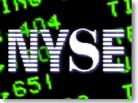|
NYSE alters circuit breakers
|
 |
February 6, 1998: 8:46 a.m. ET
New rules allow for greater trading fluctuation before breakers kick in
|
NEW YORK (CNNfn) - The New York Stock Exchange board of directors approved a plan to increase circuit breaker thresholds by using a percentage-based system rather than the current fixed-point system.
The proposal, approved Thursday, calls for the market to close only if it incurs a "severe decline," defined as a drop of 10 percent, 20 percent or 30 percent.
The U.S. Securities and Exchange Commission still must approve the plan, but an SEC spokesman said Thursday the commission is "very encouraged" by the proposal.
Under the proposed changes, the threshold will be adjusted quarterly, based on the average closing of the Dow Jones industrials index for the previous month.
That means that if these changes were in effect, Thursday's thresholds, based on the Dow's December 1997 closing averages of 7909.82, would have been 800 points, 1,600 points and 2,400 points for the 10, 20, and 30 percent levels, respectively.
The rules for 10 percent drop are:
- If the Dow falls 10 percent before 2 p.m., the market will close for one hour.
- Between 2 and 2:30 p.m., the market will close for 30 minutes.
- After 2:30 p.m., the 10 percent threshold will be removed.
The rules for a 20 percent drop are:
- If the Dow falls 20 percent before 1 p.m., the market will close for two hours.
- Between 1 and 2 p.m., a 20 percent drop will close the market for one hour.
- After 2 p.m., a 20 percent drop will close the market for the day.
A 30-percent Dow decline will close the market for the day, regardless of what time it occurs.
Many market players and regulators called for widening the trading-halt triggers to declines of 10 percent and 20 percent in the Dow after the circuit breakers were tripped for the first time ever in October last year.
The plan does not change so-called sidecar curbs, which are triggered when the Standard & Poor's 500 futures contract drops 12 points.
When that happens, all program trading market orders for NYSE-listed S&P 500 stocks are set aside for five minutes.
It also does not change an index arbitrage restriction, which limits that type of program trading when the Dow rises or falls 50 points above or below its close from the previous trading day, the exchange said.
The halts were first proposed by the Brady Commission after the 1987 stock market crash. At the time, the curbs were put at 250 points and 400 points, but were widened to 350 points and 550 points early in 1997.
-- from staff and wire reports
|
|
|
|
|
 |

|

